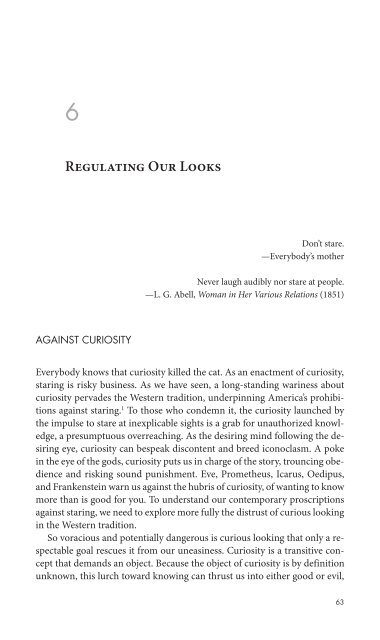Staring how we look sobre la mirada.pdf - artecolonial
Staring how we look sobre la mirada.pdf - artecolonial
Staring how we look sobre la mirada.pdf - artecolonial
Create successful ePaper yourself
Turn your PDF publications into a flip-book with our unique Google optimized e-Paper software.
A CULTURAL HISTORY 27<br />
enemies and other hexes with a symbol of the eye. Amulets, the precursors<br />
to modern je<strong>we</strong>lry, served a symbolic function simi<strong>la</strong>r to Medusa’s head by<br />
turning like against like in homeopathic fashion. Amulets work as remnants,<br />
much like relics, containing concentrated and residual po<strong>we</strong>r. Plutarch says<br />
amulets “engage the forces of attraction; they defeat fascination with fascination”<br />
(Siebers 1983, 7). With the banishment of superstition and enchantment,<br />
modern English has redefined words such as “fascinating” and<br />
“charming.” But the linguistic remainder of the evil eye persists in the root<br />
word “fascinate,” which comes from the Latin word fascinatus, meaning evil<br />
spell. We have shifted our obsessions with staring from superstition to science,<br />
but the force of the stare remains.<br />
Vision was important to the medieval Church, delivering the Christian<br />
story in visual form to illiterate masses. Religious practices such as the veneration<br />
of images, the spectacle of mystery p<strong>la</strong>ys, the flood of stained-g<strong>la</strong>sscolored<br />
light in Gothic cathedrals, the cult of relics, and the illumination of<br />
manuscripts depend on seeing for their didactic effect. A po<strong>we</strong>rful force,<br />
vision was also the vehicle of temptation, and this link bet<strong>we</strong>en vision and<br />
temptation developed during the Protestant Reformation into a widespread<br />
iconophobia even while the Eastern Orthodox churches remained iconophile.<br />
For Protestants, the observable world was evanescent and profane,<br />
and it obscured the spiritual realm. The Reformation was deeply distrustful<br />
of the extravagantly visual, elevating the spare word of God above the image<br />
and emptying the Cross of the scene of the wounded Christ. In contrast, the<br />
Counter-Reformation used the opulence and “aggrandizement of the eye”<br />
of the Baroque in attempts to return the Catholic Church to dominance (Jay<br />
1993, 46). Though Protestantism rep<strong>la</strong>ced the image with the word, it still<br />
relied on sight to spread its religion. The inscribed and <strong>la</strong>ter printed Word<br />
of God was made avai<strong>la</strong>ble to individual follo<strong>we</strong>rs in the form of Protestant<br />
Bibles, and Christian martyrdom as a form of witnessing and visions of a<br />
resurrected Jesus restored to wholeness persisted.<br />
As the seventeenth century took hold, seeing developed new forms in<br />
a secu<strong>la</strong>rizing, democratizing world. Observation rep<strong>la</strong>ced witnessing with<br />
the rise of rationalism and scientific inquiry. Literacy and the printed word<br />
flourished. The modernizing world celebrated earthly rather than heavenly<br />
sights in art and technology. The early modern period gave us perspective—<br />
the artistic convention invented in Renaissance Italy that replicated human<br />
vision in artistic representation and created the illusion of reality. The visual<br />
technique of perspective both reflected and contributed to the development<br />
of individualism by validating the single spectator whose point of view controls<br />
the scene (Berger 1972). Thus perspective helps to transform the individual<br />
vie<strong>we</strong>r into a gatekeeper of knowledge regarding the scene depicted,<br />
shutting down the possibility of competing knowledges that might emerge


